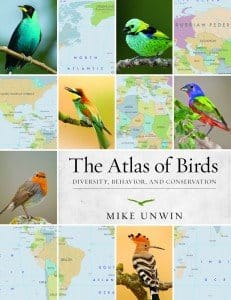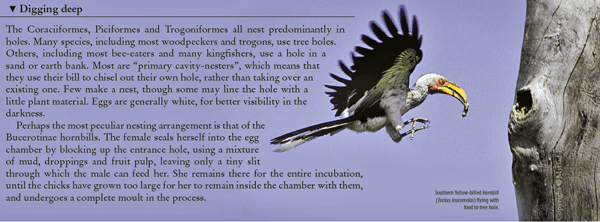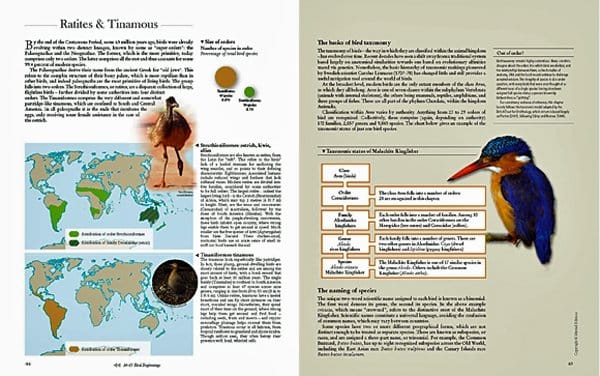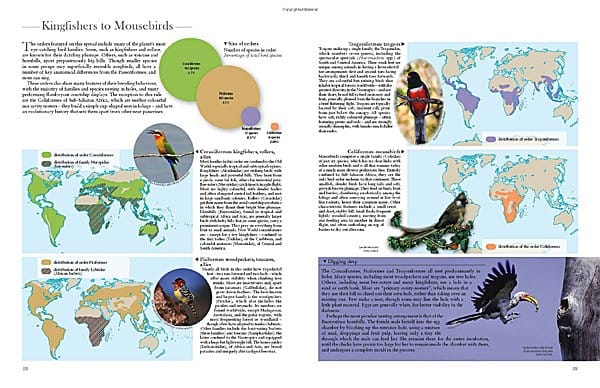 Be warned, The Atlas of Birds is not a map book, though it does contain maps, lovely orange and purple and green bird distribution maps. It is not an encyclopedia, though it does summarize research, explain basic concepts, and ends with a section on bird statistics. And, it is not a coffee table book, though it is on the large size (11 x 8.5) and contains many bright, crisp photographs and other visual goodies. Feast your eyes on the burgandy and ochre pie charts, the drawings comparing birds’ toes and bills, the nifty bar graphs on everything from birds in Shakespeare to bird extinction numbers on islands and continents.
Be warned, The Atlas of Birds is not a map book, though it does contain maps, lovely orange and purple and green bird distribution maps. It is not an encyclopedia, though it does summarize research, explain basic concepts, and ends with a section on bird statistics. And, it is not a coffee table book, though it is on the large size (11 x 8.5) and contains many bright, crisp photographs and other visual goodies. Feast your eyes on the burgandy and ochre pie charts, the drawings comparing birds’ toes and bills, the nifty bar graphs on everything from birds in Shakespeare to bird extinction numbers on islands and continents.
The Atlas of Birds: Diversity, Behavior, and Conservation by Mike Unwin is a collection of data about birds and their environments presented through words, graphics, and photographs. It is a fascinating book that teaches while it entertains, that offers research-informed arguments for bird protection and conservation in the guise of vibrant design. It would be a great gift for the novice birder, the experienced naturalist, or a fun read if you want to treat yourself.
It is pretty amazing how much information Mike Unwin compresses into the book’s 144 pages. The Atlas of Birds is presented in eight parts: an Introduction to Birds (evolution, structure, feathers); Where Birds Live (endemics, Important Bird Areas, places); Birds in Order (a rundown of the taxonomic families); How birds Live (feeding, nesting, migrating), Birds and People (we eat them, paint them, study them, and sometimes get very angry at them); Birds under Threat (extinction, loss of habitat, pollution, climate change); Protecting Birds (Birdlife International, campaigns, protecting places, citizen science); and the Bird Table (eight pages of country-by country avian and environmental statistics).
Here is a sample of a chapter, “Ratites & Tinamous”, from the Birds in Order section. Intriguing, isn’t it? General information, like an explanation of taxonomic structure, is juxtaposed next to the specific. And so, I learn from this page that each bird’s scientific name is unique, a combination of its genus and species names. Also, I learn that the Malachite Kingfisher’s scientific name is Alcedo cristata, and that cristata, the species name, means “crowned”. Coverage is global, though there is a slight emphasis on birding and conservation activities in Great Britain. Mike Unwin, the author, is a British natural history and travel writer who spent eight years living and working in southern Africa; his previous titles include the RSPB Guide to Birdwatching.
Each 2-page chapter is designed as a graphic whole, with text and graphics playing off of each other in a wonderfully complementary way. In the earlier chapters, the maps illustrate bird species distribution. In later chapters, the maps illustrate global aspects of the dangers posed to birds (coal mining in Appalachia threatens the Cerulean Warbler while lead ingested from ammunition threatens the Spanish Imperial Eagle in Europe). Photographs (most are from photographic stock companies) allow the maps to tell visual stories. Isabelle Lewis and Corinne Pearlman designed the book, with Ms. Lewis also responsible for the maps and graphics, and I think they deserve as much credit as Mike Unwin for the book’s appeal. The Atlas of Birds is part of a series produced by Myriad Editions, a British book publisher, published in the U.S. by Princeton University Press.
This is a fun book to read. Or browse or sample if that be your reading style. Here, in no particular order, are some of the “fun facts” I’ve learned:
– Trogons have weak feet, with a unique heterodactyl toe arrangement. (Yes, I had to look that word up. It means their first and second toes face backwards and their third and fourth toes face forward. One addition I would have liked is a glossary.)
– The European Goldfinch was a popular symbol in the words of Renaissance artists, symbolizing the soul, death, and resurrection. (I saw one once, in Chicago, and simply thought it was beautiful.)
– A Laysan Albatross was found dead on Midway Atoll, its carcass full of ingested plastic objects, including toothbrushes, cigarette lighters, and bottle tops.
– The Takahe, a large flightless bird endemic to New Zealand, was thought to be extinct, and then was rediscovered in 1948. It is still the focus of an intensive conservation program.
O.k., the last two items are not really “fun facts”. They are mind boggling information points that point out the thrust of this book: the need to pay attention to the dangers birds face from decreasing habitat, climate change, social practices and traditions. You may start reading The Atlas of Birds like I did, to find out more about Hornbills or Mousebirds, but you will end up furrowing your brow over massacred Common Quail and championing Important Bird Areas and BirdLife International, the umbrella organization for over 100 bird conservation organizations, including our own National Audubon.(If you are a 10,000 Birds reader and the name BirdLife International is not familiar to you, read up. We are a BirdLife Species Champion!)
The Atlas of Birds may succeed where other, more serious books fail at communicating the call for citizen action because it incorporates the message within this lively graphic format. I was happy to see that there is a Sources section with references to major bird conservation web sites. I wish there were more links to research journal articles, but that may be an unrealistic expectation in a world of expensive databases. So, we can read, skim, jump in and out, and dig deeper when we find information tidbits that capture our interest. And, hopefully engage in at least one of the campaigns, bird counts, and bird watches that are a part of the People Power outlined in the last chapter.

The Atlas of Birds: Diversity, Behavior, and Conservation is available from the usual book sources at a very reasonable price. Although not a necessary purchase, I think it is the kind of book birders will be sorry they didn’t buy if it goes out of print. I also think The Atlas of Bird’s accessibility makes it an excellent gift for the people in your life who are not birders. If the stories about Albatrosses courting and Cranes migrating don’t seduce them into some kind of bird love, the maps of birds being protected in every country on every continent on earth will give them a contemporary frame of reference and some understanding for the importance of our passion.
The Atlas of Birds: Diversity, Behavior, and Conservation, by Mike Unwin.
Princeton University Press, 2011. Paperback, 144 pages, $22.95 (retail).
ISBN: 9780691149493
All photographs used in this article are courtesy of Princeton University Press.















Looks pretty dang good. Like something you can use to learn from in an easy, pleasant way.
Thanks for the review!
This looks a lot like a book I would like to add to my Library. Darn you Donna! As if my book shelves were not already overflowing. …And you said heterodactyl! [ giggle ]
Nicole–Glad you enjoyed the review. Yes, it’s a fun book with depth.
Arie–So, should I have said zygodactyl instead? Those dactyls can be so confusing.
Ah, thanks for the reminder! I forgot to put it on my wishlist! 🙂